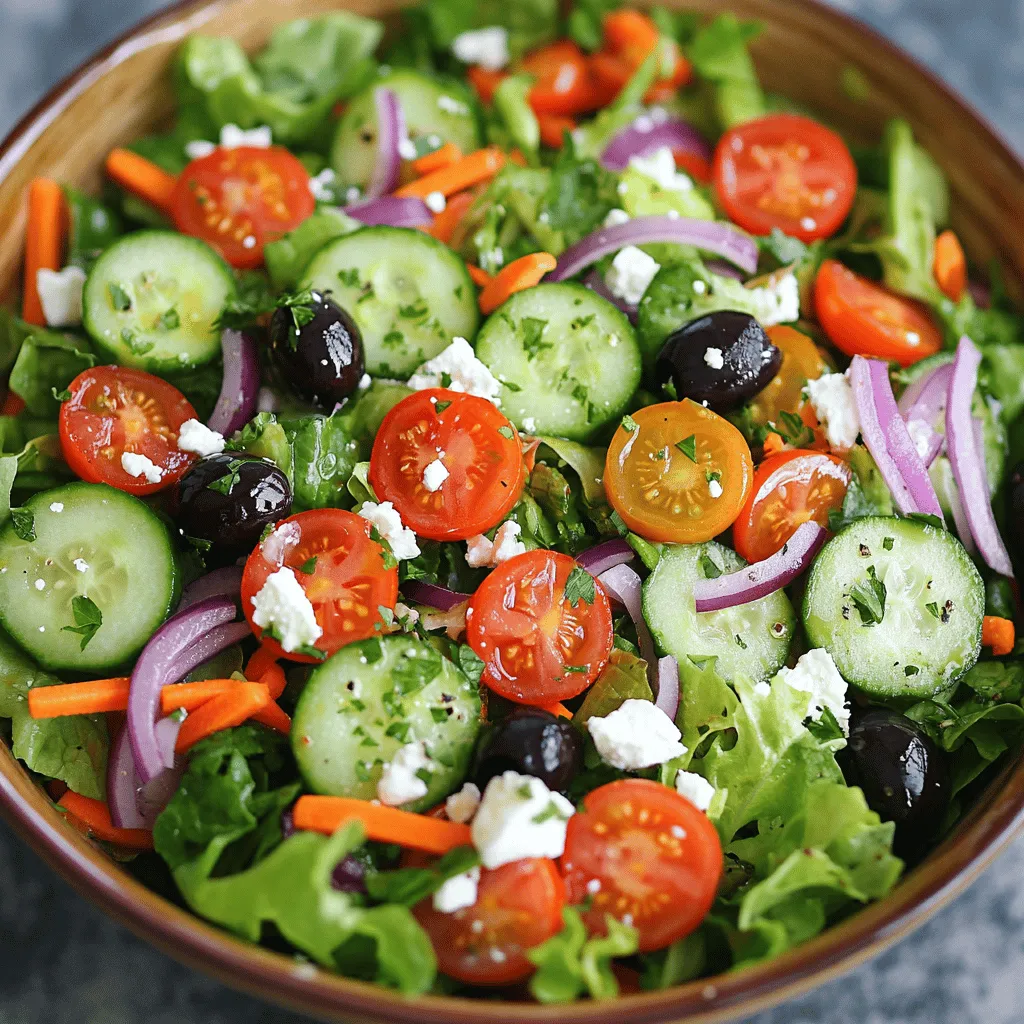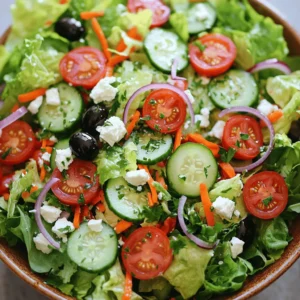Craving that iconic Olive Garden salad? You’re in the right place! This guide gives you everything you need to recreate that fresh, flavorful experience right at home. From the simple list of ingredients to step-by-step prep instructions, I’ll help you master this beloved salad. Plus, you’ll find tips, tricks, and variations to suit your tastes. Let’s dive in and make your kitchen come alive with vibrant, tasty greens!
Ingredients
List of Ingredients
– 1 head of romaine lettuce, chopped
– 2 cups mixed greens
– 1 cup cherry tomatoes, halved
– 1/2 red onion, thinly sliced
– 1/2 cucumber, sliced
– 1/2 cup pepperoncinis, sliced
– 1/3 cup black olives, pitted and sliced
– 1/3 cup feta cheese, crumbled
– 1/3 cup shredded carrots
– 1/4 cup Italian dressing (homemade or store-bought)
– Salt and pepper to taste
– Fresh parsley, chopped for garnish
To make the Olive Garden salad, you need fresh and vibrant ingredients. The romaine lettuce gives a nice crunch. The mixed greens add flavor and color. Cherry tomatoes bring a sweet bite. Red onion adds a sharp taste. Cucumber keeps it refreshing. Pepperoncinis give a little kick. Black olives add depth. Feta cheese adds creaminess. Shredded carrots give sweetness. Finally, the Italian dressing ties it all together.
Optional Ingredients
You can add extra toppings for more flavor. Try grilled chicken or shrimp for protein. Avocado gives a creamy touch. You can also use sunflower seeds for crunch. If you want a spicy kick, add sliced jalapeños. These choices can change the taste and nutrition.
Dietary Considerations
This salad fits many diets. It is gluten-free and vegetarian. For a vegan option, skip the feta cheese. You can use a vegan dressing instead. This salad is versatile and easy to modify. It can fit many food needs. Enjoy it however you like!
Step-by-Step Instructions
Preparation Steps
To start, you need to prepare the lettuce and greens. First, wash the romaine lettuce under cold water. This step is vital for removing dirt and chemicals. After washing, chop it into bite-sized pieces. Next, take the mixed greens and rinse them as well. You want them fresh and crisp. Once clean, gently pat both the romaine and mixed greens dry with a clean kitchen towel. This keeps the salad from getting soggy later.
Combining Ingredients
Now, let’s mix the salad ingredients. In a large salad bowl, add your chopped romaine and mixed greens first. This creates a colorful base. Next, add the halved cherry tomatoes and sliced cucumbers for sweetness and crunch. Carefully toss in the thinly sliced red onion, pepperoncinis, and black olives. It’s best to mix these ingredients gently to avoid bruising the greens. Once everything is in the bowl, sprinkle the crumbled feta and shredded carrots on top. This adds both flavor and texture.
Dressing the Salad
Dressing the salad is where the magic happens. Use about 1/4 cup of Italian dressing. Drizzle it evenly across the top of your salad. This ensures every bite has flavor. After that, gently toss everything together. Make sure all the greens and toppings are coated in dressing. Finally, season your salad with salt and pepper to taste. Adjust the seasoning based on what you like. For a final touch, garnish with freshly chopped parsley. This not only looks nice but also boosts the flavor. Serve immediately for the best taste. Check out the Full Recipe for more details!
Tips & Tricks
Perfecting Texture
To keep your greens crisp, choose fresh ingredients. Look for vibrant, firm leaves. Rinse your romaine and mixed greens in cold water. Dry them well using a salad spinner or paper towels. This step helps remove excess moisture, which can lead to soggy greens. Store your salad in the fridge until serving. This keeps everything fresh and crunchy.
Flavor Enhancements
To boost the flavor of your Olive Garden salad, consider these tips. Use fresh herbs like parsley or basil for a fragrant touch. Adding a squeeze of lemon juice brightens the taste. Try using different dressings. A balsamic vinaigrette or a zesty lemon dressing can elevate the salad. You can also toss in some nuts or seeds for crunch and added flavor.
Serving Suggestions
Presentation is key when serving your salad. Use a large, colorful bowl for a vibrant look. Layer your ingredients for visual appeal. Start with greens, then add tomatoes and cucumbers. Sprinkle cheese and olives on top for a beautiful finish. Serve immediately for the best taste. This way, guests enjoy the salad while it is fresh. For an extra touch, garnish with fresh parsley. It adds color and a hint of flavor.
For the full recipe, check out the Garden Fresh Olive Garden Salad.

Variations
Ingredient Substitutions
You can swap ingredients in this Olive Garden salad to fit your taste. If you don’t like feta, try goat cheese or mozzarella. For a crunchier texture, add radishes instead of cucumbers. If pepperoncinis are too spicy, use sweet bell peppers. You can also add chickpeas for a vegetarian protein boost.
Seasonal Variations
Change the salad with the seasons for fresh flavors. In spring, add peas and asparagus for a bright touch. During summer, use ripe peaches or strawberries for sweetness. In fall, add roasted butternut squash and walnuts for warmth. In winter, use hearty greens like kale or spinach to keep it fresh.
Add-ins for Extra Nutrition
Want to make your salad more filling? Add grilled chicken or shrimp for lean protein. For fiber, mix in black beans or quinoa. Nuts and seeds can give a crunchy texture, too. These add-ins will help you create a more balanced meal while keeping it tasty. For the full recipe, check out the complete guide.
Storage Info
Storing Leftovers
To store your Olive Garden salad, first, keep it in a container with a lid. Make sure to separate any dressing to keep the greens fresh. If you mix it all together, the salad may get soggy. Place the container in the fridge right away. This keeps the salad crisp and tasty.
How Long Does it Last?
Your prepared salad lasts about 3 days in the fridge. After that, the greens lose their crunch. If you see any brown spots, it’s time to toss it. Always check for freshness before enjoying leftovers.
Reheating Tips
You should not reheat your salad. It tastes best cold. Heating can wilt the greens and change the texture. Enjoy it straight from the fridge for a refreshing bite. For more tips, you can check the Full Recipe.
FAQs
What is the Olive Garden Salad recipe?
The Olive Garden Salad recipe is a fresh and colorful mix of greens and toppings. People love this salad for its bright flavors and crunchy textures. It typically includes romaine lettuce, mixed greens, cherry tomatoes, red onion, cucumber, pepperoncinis, black olives, feta cheese, and shredded carrots.
This salad often comes with Italian dressing, making it extra tasty. It’s a favorite at Olive Garden and has a strong fan base worldwide. The combination of ingredients gives it a unique flavor profile. If you want to try it at home, you can find the full recipe online.
How can I make it healthier?
To make the Olive Garden Salad healthier, you can try a few simple swaps. First, use a lighter dressing, like a vinaigrette, instead of creamy options. You can also cut down on cheese or use a lower-fat version of feta. If you want more veggies, add extra cucumbers or bell peppers.
You might also try swapping black olives for green olives, which can reduce sodium. Adding more leafy greens can boost fiber without adding many calories. These small changes can make a big difference.
Can I make it ahead of time?
Yes, you can make the Olive Garden Salad ahead of time! This salad keeps well in the fridge for a day or two. To do this, prepare the veggies and store them in an airtight container. Keep the dressing separate until you are ready to eat.
Add the dressing right before serving to keep the greens crisp. You can also prep individual servings in jars, layering the ingredients. This method makes it easy to grab a salad on the go.
This blog post covered how to create a delicious salad, focusing on key ingredients and their preparation. We explored options for dietary needs and added tips to enhance flavor and texture. You can adapt the recipe with substitutions for different seasons and nutrition boosts. Remember to store your leftovers properly to keep them fresh. With this knowledge, you can enjoy a fresh, homemade salad anytime you desire. Embrace your creativity and enjoy healthy eating!

